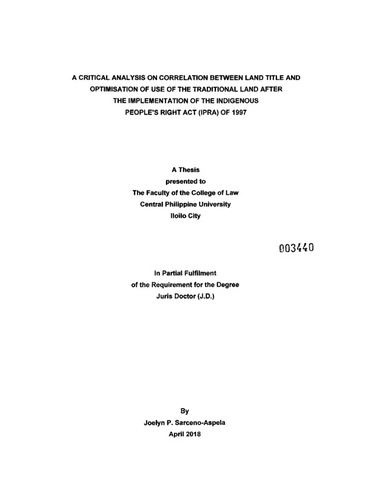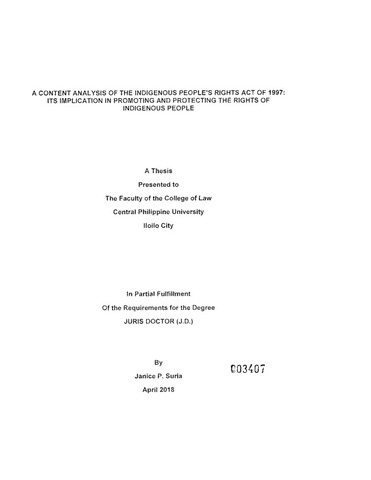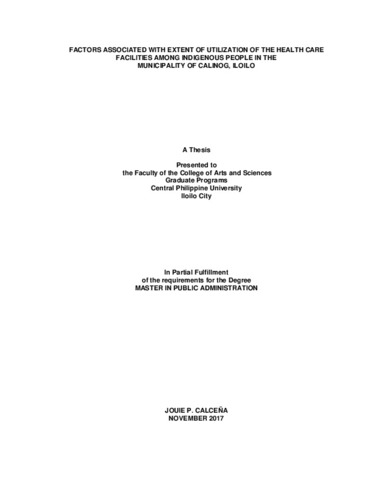Indigenous dispute settlement: Learning from the Panay Bukidnon tribe
| dc.contributor.author | Rio, Irving Domingo | |
| dc.coverage.spatial | Central Panay | en_US |
| dc.date.accessioned | 2021-11-03T01:49:07Z | |
| dc.date.available | 2021-11-03T01:49:07Z | |
| dc.date.issued | 2016-02 | |
| dc.identifier.citation | Rio, I. D. L. (2016). Indigenous dispute settlement: Learning from the Panay Bukidnon tribe International Journal of Humanities and Social Science. International Journal of Humanities and Social Science, 6(11), 73-80. | en_US |
| dc.identifier.issn | 2220-8488 | |
| dc.identifier.uri | https://hdl.handle.net/20.500.12852/1637 | |
| dc.description | Journal article | en_US |
| dc.description.abstract | Settling dispute is of utmost importance in the maintenance of social order. Regardless of the forms of governments, its nature of existence is universal throughout history and that it exists to regulate conflict. Different government institutions exist and are tasked to maintain order. The focus of dispute settlement as a process is to reach an agreement between conflicting parties through third party mediator/ arbiters. In the Panay- Bukidnon culture there is no clear distinction between arbitration and mediation. The indigenous cultural communities of Central Panay Mountains, collectively called the Panay Bukidnon, have been able to preserve their indigenous dispute settlement system to this day. This research study was conducted to explore the uniqueness of the Panay Bukidnon’s dispute settlement process. Ethnographic investigation revealed several salient features of the Panay Bukidnon culture, specifically in the area of peace process. The culture of vengeance is the main player in dispute settlement processes among the Panay Bukidnon tribe. Furthermore, key personalities such as the recognized elders, locally known as magurang and the padara or village emissary are essential in ensuring the success of the peace processes of the tribe. Expressions of grief and vengeance known as kantang and ugh at are also revealed during disputes that involve loss of life. | en_US |
| dc.description.sponsorship | Central Philippine University | en_US |
| dc.language.iso | en | en_US |
| dc.publisher | Center for Promoting Ideas (CPI) | en_US |
| dc.relation.uri | http://www.ijhssnet.com/view.php?u=http://www.ijhssnet.com/journals/Vol_6_No_11_November_2016/9.pdf | en_US |
| dc.subject.lcsh | Conflict management | en_US |
| dc.subject.lcsh | Indigenous peoples | en_US |
| dc.subject.lcsh | Justice, Administration of | en_US |
| dc.subject.lcsh | Indigenous peoples--Legal status, laws, etc. | en_US |
| dc.subject.lcsh | Philippines--Panay Island | en_US |
| dc.title | Indigenous dispute settlement: Learning from the Panay Bukidnon tribe | en_US |
| dc.type | Article | en_US |
| dc.citation.firstpage | 73 | en_US |
| dc.citation.lastpage | 80 | en_US |
| dc.citation.journaltitle | International Journal of Humanities and Social Science | en_US |
| dc.citation.volume | 6 | en_US |
| dc.citation.issue | 11 | en_US |
| local.subject | Indigenous dispute settlement | en_US |
| local.subject | Panay Bukidnon | en_US |
| local.subject | Indigenous people | en_US |
| local.subject | Magurang | en_US |
| dc.identifier.essn | 2221-0989 | |
| local.relation.associatedcontent | https://repository.cpu.edu.ph/handle/20.500.12852/1287 Research report | en_US |
Fichier(s) constituant ce document
Ce document figure dans la(les) collection(s) suivante(s)
-
Journal articles [11]





